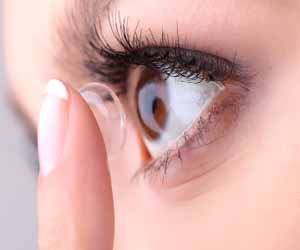- Home
- Editorial
- News
- Practice Guidelines
- Anesthesiology Guidelines
- Cancer Guidelines
- Cardiac Sciences Guidelines
- Critical Care Guidelines
- Dentistry Guidelines
- Dermatology Guidelines
- Diabetes and Endo Guidelines
- Diagnostics Guidelines
- ENT Guidelines
- Featured Practice Guidelines
- Gastroenterology Guidelines
- Geriatrics Guidelines
- Medicine Guidelines
- Nephrology Guidelines
- Neurosciences Guidelines
- Obs and Gynae Guidelines
- Ophthalmology Guidelines
- Orthopaedics Guidelines
- Paediatrics Guidelines
- Psychiatry Guidelines
- Pulmonology Guidelines
- Radiology Guidelines
- Surgery Guidelines
- Urology Guidelines
Smart contact lenses measure blood sugar levels the easier way

Korea: In a bid to find easier ways for the measurement of blood sugar, a team of researchers from Korea has developed a wireless rechargeable smart contact lens with a small LED light that turns off and off in correspondence to the blood sugar levels. The researcher, in their study, published in the journal Science Advances describes how they made their contact lens and how well it worked during the test. This new technology might take wearable tech to a new level.
But how might these lenses be powered? Traditional batteries are too large, too hard and produce too much heat to be incorporated into a comfortable lens. For this, the researchers have developed a printable supercapacitor that can be integrated into a contact lens alongside an antenna and a red LED – all without obscuring the wearer’s vision.
It is an integral part of every diabetes control to monitor blood sugar, of course, the mode of blood sugar testing may differ. The current standard method for glucose testing at home involves the use of a portable glucometer that involves pricking of the fingertips to get a blood sample. This process can be painful and also, carries a risk of infection.
Previous research has shown that human tears can be used to test for glucose levels, so many are looking at ways to obtain it for testing.
Read Also: Biosensor fitted glasses a painless method of measuring blood sugar in diabetes
In this new effort, the team in Korea has designed and built a contact lens with a tiny LED light that remains lit when glucose levels are normal and turn off when they go too high—they have named it, aptly enough, the "wireless smart contact lens." The device exploits the body's automatic and continuous secretion of tears to keep the eyes from drying out.
To make the new contact lens, the team used ultra-fine printing methods to create rectifier circuits, a supercapacitor, and an LED that were small enough to fit inside the normal contact lens. The circuits and the supercapacitor were also printed with the same clear material that was used to make soft contact lenses to obstruct vision. The arrangement also allowed the device to be charged wirelessly, which means that it does not have to be removed for charging. The researchers report that when the contact is in the eye, only the LED is visible to the user and does not obstruct the view because it is placed over the iris and not over the pupil.
Read Also: Type 2 diabetes: Eye device that measures blood sugar levels granted patent
They also report that the contact lens itself is identical to commercial soft contact lenses. The saying that a guinea pig equipped with the lens showed no signs of discomfort and the LED went on and off just as designed. The assembly was tested on a mannequin, before being trialled on live rabbits and finally a human. During the 10 minutes human trial, no damage was detected to the wearer’s eye.
The study, "Printing of wirelessly rechargeable solid-state supercapacitors for soft, smart contact lenses with continuous operations," is published in the journal Science Advances.
Journal -Science Advances

Disclaimer: This site is primarily intended for healthcare professionals. Any content/information on this website does not replace the advice of medical and/or health professionals and should not be construed as medical/diagnostic advice/endorsement or prescription. Use of this site is subject to our terms of use, privacy policy, advertisement policy. © 2020 Minerva Medical Treatment Pvt Ltd